Buxton, W. (1986) There's More to Interaction than Meets the Eye: Some
Issues in Manual
Input. In Norman, D. A. and Draper, S. W. (Eds.), (1986), User Centered
System Design:
New Perspectives on Human-Computer Interaction. Lawrence Erlbaum Associates,
Hillsdale,
New Jersey, 319-337.
There's More to Interaction than Meets the Eye:
Some Issues in Manual Input
Bill Buxton
INTRODUCTION
Imagine a time far into the future, when all knowledge about our civilization
has been lost. Imagine further, that in the course of planting a garden,
a fully stocked computer store from the 1980's was unearthed, and that all
of the equipment and software was in working order. Now, based on this find,
consider what a physical anthropologist might conclude about the physiology
of the humans of our era? My best guess is that we would be pictured as
having a well-developed eye, a long right arm, uniform-length fingers and
a "low-fi" ear. But the dominating characteristic would be the
prevalence of our visual system over our poorly developed manual dexterity.
Obviously, such conclusions do not accurately describe humans of the twentieth
century. But they would be perfectly warranted based on the available information.
Today's systems have severe shortcomings when it comes to matching the physical
characteristic of their operators. Admittedly, in recent years there has
been a great improvement in matching computer output to the human visual
system. We see this in the improved use of visual communication through
typography, color, animation, and iconic interfacing. Hence, our speculative
future anthropologist would be correct in assuming that we had fairly well
developed (albeit monocular) vision.
In our example, it is with the human's effectors (arms, legs, hands, etc.)
that the greatest distortion occurs. Quite simply, when compared to other
human operated machinery (such as the automobile), today's computer systems
make extremely poor use of the potential of the human's sensory and motor
systems. The controls on the average user's shower are probably better human-engineered
than those of the computer on which far more time is spent. There are a
number of reasons for this situation. Most of them are understandable, but
none of them should be acceptable.
My thesis is that we can achieve user interfaces that are more natural,
easier to learn, easier to use, and less prone to error if we pay more attention
to the "body language" of human computer dialogues. I believe
that the quality of human input can be greatly improved through the use
of appropriate gestures. in order to achieve such benefits, however,
we must learn to match human physiology, skills, and expectations with our
systems' physical ergonomics, control structures, and functional organization.
In this chapter I look at manual input with the hope of developing better
understanding of how we can better tailor input structures to fit the human
operator.
A FEW WORDS ON APPROACH
Due to constraints on space, I restrict myself to the discussion of manual
input. I do so fully realizing that most of what I say can be applied to
other parts of the body, and I hope that the discussion will encourage the
reader to explore other types of transducers.
Just consider the use of the feet in sewing, driving an automobile
or in playing the pipe organ. Now compare this to your average computer
system. The feet are totally ignored despite the fat that most users have
them, and furthermore, have well developed motor skills in their use.
I resist the temptation to discuss exotic technologies. I want to stick
with devices that are real and available, since we haven't come close to
using the full potential of those that we already have.
Finally, my approach is somewhat cavalier. I will leap from example to example,
and just touch on a few of the relevant points. In the process, it is almost
certain that readers will be able to come up with examples counter to my
own, and situations where what I say does not apply. But these contradictions
strengthen my argument! Input is complex, and deserves great attention
to detail: more than it generally gets. That the grain of my analysis is
still not fine enough just emphasizes how much more we need to understand.
Managing input is so complex that it is unlikely that we
will ever totally understand it. No matter how good our theories are, we
will probably always have to test designs through actual implementations
and prototyping. The consequence of this for the designer is that the prototyping
tools (software and hardware) must be developed and considered as part of
the basic environment.
THE IMPORTANCE OF THE TRANSDUCER
When we discuss user interfaces, consideration of the physical transducer
too often comes last, or near last. And yet, the physical properties of
the system are those with which the user has the first and most direct contact.
This is not just an issue of comfort. Different devices have different properties,
and lend themselves to different things. And if gestures are as important
as I believe, then we must pay careful attention to the transducers to which
we assign them.
An important concept in modern interactive systems is the notion of device
independence. The idea is that input devices fall into generic classes
of what are known as virtual devices, such as "locators" and "valuators."
Dialogues are described in terms of these virtual devices. The objective
is to permit the easy substitution of one physical device for another of
the same class. One benefit in this is that it facilitates experimentation
(with the hopeful consequence of finding the best among the alternatives).
The danger, however, is that one can be easily lulled into believing that
the technical interchangeability of these devices extends to usability.
Wrong! It is always important to keep in mind that even devices within the
same class have very idiosyncratic difference that determine the appropriateness
of a device for a give context. So, device independence is a useful concept,
but only when additional considerations are made when making choices.
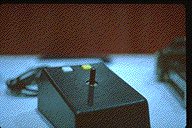

Figure 1: Two Isometric Joysticks
Example 1: The Isometric Joystick
An isometric joystick is a joystick whose handle does not move when it is
pushed. Rather, its shaft senses how hard you are pushing it, and in what
direction. It is, therefore, a pressure-sensitive device. Two isometric
joysticks are shown in Figure 1. They are both made by the same manufacturer.
They cost about the same, and are electronically identical. In fact, they
are plug compatible. How they differ is in their size, the muscle groups
that they consequently employ, and the amount of force required to get a
given output.
Remember, people generally discuss joysticks vs mice or trackballs.
Here we are not only comparing joysticks against joysticks, we are comparing
one isometric joystick to another.
When should one be used rather than the other? The answer obviously depends
on the context. What can be said is that their differences may often be
more significant than their similarities. In the absence of one of the pair,
it may be better to utilize a completely different type of transducer (such
as a mouse) than to use the other isometric joystick.
Example 2: Joystick vs. Trackball
Let's take an example in which subtle idiosyncratic differences have a strong
effect on the appropriateness of the device for a particular transaction.
In this example we will look at two different devices. One is the joystick
shown in Figure 2(a).
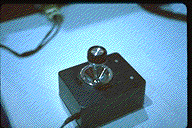
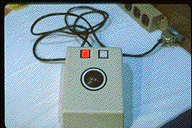
(a) (b)
Figure 2: A 3-D Joystick (a) and a 3-D Trackball (b).
In many ways, it is very similar to the isometric joysticks seen in the
previous example. It is made by the same manufacturer, and it is plug-compatible
with respect to the X/Y values that it transmits. However, this new joystick
moves when it is pushed, and (as a result of spring action) returns to the
center position when released. In addition, it has a third dimension of
control accessible by manipulating the self-returning spring-loaded rotary
pot mounted on the top of the shaft.
Rather than contrasting this to the joysticks of the previous example (which
would, in fact, be a useful exercise), let us compare it to the 3-D trackball
shown in Figure 2(b). (A 3-D trackball is a trackball constructed so as
to enable us to sense clockwise and counter-clockwise "twisting"
of the ball as well as the amount that it has been"rolled" in
the horizontal and vertical directions.)
This trackball is plug compatible with the 3-D joystick, costs about the
same, has the same "footprint" (consumes the same amount of desk
space), and utilizes the same major muscle groups. It has a great deal in
common with the 3-D joystick of Figure 2(a).
In many ways the trackball has more in common with the joystick in Figure
2(a) than do the joysticks shown in Figure 1!
If you are starting to wonder about the appropriateness of
always characterizing input devices by names such as "joystick"
or "mouse", then the point of this section is getting across.
It is starting to seem that we should lump devices together according to
some "dimension of maximum significance", rather than by some
(perhaps irrelevant) similarity in their mechanical construction (such as
being a mouse or joystick). The prime issue arising from this recognition
is the problem of determining which dimension is of maximum significance
in a given context. Another is the weakness of our current vocabulary to
express such dimensions.
Despite their similarities, these two devices differ in a very subtle, but
significant, way. Namely, it is much easier to simultaneously control all
three dimensions when using the joystick than when using the trackball.
In some applications this will make no difference. But for the moment, we
care about instances where it does. We will look at two scenarios.
Scenario 1: CAD
We are working on a graphics program for doing VLSI layout. The chip on
which we are working is quite complex. The only way that the entire mask
can be viewed at one time is at a very small scale. To examine a specific
area in detail, therefore, we must "pan" over it, and "zoom
in". With the joystick, we can pan over the surface of the circuit
by adjusting the stick position. Panning direction is determined by the
direction in which the spring-loaded stick is off-center, and speed is determined
by its distance off-center. With the trackball, we exercise control by rolling
the ball in the direction and at the speed that we want to pan.
Panning is easier with trackball than the spring-loaded joystick.
This is because of the strong correlation (or compatibility) between stimulus
(direction, speed and amount of roll) and response (direction, speed and
amount of panning) in this example. With the spring-loaded joystick, there
was a position-to-motion mapping rather than the motion-to-motion mapping
seen with the trackball. Such cross-modality mappings require learning and
impede achieving optimal human performance. These issues address the properties
of an interface that Hutchins, Hollan and Norman (Chapter 5) call "formal
directions."
If our application demands that we be able to zoom and pan simultaneously,
then we have to reconsider our evaluation. With the joystick, it is easy
to zoom in and out of regions of interest while panning. One need only twist
the shaft-mounted pot while moving the stick. However, with the trackball,
it is nearly impossible to twist the ball at the same time that it is being
rolled. The 3D trackball is, in fact, better described as a 2+1D device.
Scenario 2: Process Control
I am using the computer to control an oil refinery. The pipes and valves
of a complex part of the system are shown graphically on the CRT, along
with critical status information. My job is to monitor the status information
and when conditions dictate, modify the system by adjusting the settings
of specific valves. I do this by means of direct manipulation. That
is, valves are adjusted by adjusting their graphical representation on the
screen. Using the joystick, this is accomplished by pointing at the desired
valve, then twisting the pot mounted on the stick. However, it is difficult
to twist the joystick-pot without also causing some change in the X and
Y values. This causes problems, since graphics pots may be in close proximity
on the display. Using the trackball, however, the problem does not occur.
In order to twist the trackball, it can be (and is best) gripped so that
the finger tips rest against the bezel of the housing. The finger tips thus
prevent any rolling of the ball. Hence, twisting is orthogonal to motion
in X and Y. The trackball is the better transducer in this example precisely
because of its idiosyncratic 2+D property.
Thus, we have seen how the very properties that gave the
joystick the advantage in the first scenario were a liability in the second.
Conversely, with the trackball, we have seen how the liability became an
advantage. What is to be learned here is that if such cases exist between
these two devices, then it is most likely that comparable (but different)
cases exist among all devices. What we are most lacking is some reasonable
methodology for exploiting such characteristics via an appropriate matching
of device idiosyncrasies with structures of the dialogue.
APPROPRIATE DEVICES CAN SIMPLIFY SYNTAX
In the previous example we saw how the idiosyncratic properties of an input
device could have a strong affect on its appropriateness for a specific
task. It would be nice if the world was simple, and we could consequently
figure out what a system was for, find the optimal device for the task to
be performed on it, and be done. But such is seldom the case. Computer systems
are more often used by a number of people for a number of tasks, each with
their own demands and characteristics. One approach to dealing with the
resulting diversity of demands is to supply a number of input devices, one
optimized for each type of transaction. However, the benefits of the approach
would generally break down as the number of devices increased. Usually,
a more realistic solution is to attempt to get as much generality as possible
from a smaller number of devices. Devices, then, are chosen for their range
of applicability. This is, for example, a major attraction of graphics tablets.
They can emulate the behavior of a mouse. But unlike the mouse, they can
also be used for tracing artwork to digitize it into the machine.
Having raised the issue, we will continue to discuss devices in such a way
as to focus on their idiosyncratic properties. Why? Because by doing so,
we will hopefully identify the type of properties that one might try to
emulate, should emulation be required.
It is often useful to consider the user interface of a system as being made
up of a number of horizontal layers. Most commonly, syntax is considered
separately from semantics, and lexical issues independent from syntax. Much
of this way of analysis is an outgrowth of the theories practiced in the
design and parsing of artificial languages, such as in the design of compilers
for computer languages. Thinking of the world in this way has many benefits,
not the least of which is helping to avoid "apples-and-bananas"
type comparisons. There is a problem, however, in that it makes it too easy
to fall into the belief that each of these layers is independent. A major
objective of this section is to point out how false an assumption this is.
In particular, we will illustrate how decisions at the lowest level, the
choice of input devices, can have a pronounced effect on the complexity
of the system and on the user's mental model of it.
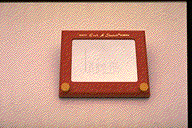
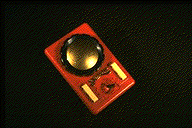
(a) Etch-a-Sketch (b) Skedoodle
With the Etch-a-Sketch (a), two 1 dimensional controls (rotary
potentiometers) are used for drawing. With the Skedoodle (b) one two dimensional
control (a joystick) is used .
Figure 3: Two "semantically identical" Children's Drawing
Toys
Two Children's Toys
The Etch-a-Sketch (shown in Figure 3(a)) is a childrens' drawing
toy that has had a remarkably long life in the marketplace. One draws by
manipulating the controls so as to cause a stylus on the back of the drawing
surface to trace out the desired image. There are only two controls: both
are rotary pots. One controls left-right motion of the stylus and the other
controls its up-down motion.
The Skedoodle (shown in Figure 3(b)) is another toy based on very
similar principles. In computerese, we could even say that the two toys
are semantically identical. They draw using a similar stylus mechanism and
even have the same "erase" operator (turn the toy upside down
and shake it). However, there is one big difference. Whereas the Etch-a-Sketch
has a separate control for each of the two dimensions of control, the Skedoodle
has integrated both dimensions into a single transducer: a joystick.

(a) Geometric Figure (b) Cursive Script
Figure 4: Two Drawing Tasks
Since both toys are inexpensive and widely available, they offer an excellent
opportunity to conduct some field research. Find a friend and demonstrate
each of the two toys. Then ask him or her to select the toy felt to be the
best for drawing. What all this is leading to is a drawing competition between
you and your friend. However, this is a competition that you will always
win. The catch is that since your friend got to choose toys, you get to
choose what is drawn. If your friend chose the Skedoodle (as do the majority
of people), then make the required drawing be of a horizontally-aligned
rectangle, as in Figure 4a. If they chose the Etch-a-Sketch, then have the
task be to write your first name, as in Figure 4b. This test has two benefits.
First, if you make the competition a bet, you can win back the money that
you spent on the toys (an unusual opportunity in research). Secondly, you
can do so while raising the world's enlightenment about the sensitivity
of the quality of input devices to the task to which they are applied.
If you understand the importance of the points being made
here, you are hereby requested to go out and apply this test on every person
that you know who is prone to making unilateral and dogmatic statements
of the variety "mice (tablets, joysticks, trackballs, ...) are best".
What is true with these two toys (as illustrated by the example) is equally
true for any and all computer input devices: they all shine for some tasks
and are woefully inadequate for others.
We can build upon what we have seen thus far. What if we asked how we can
make the Skedoodle do well at the same class of drawings as the Etch-a-Sketch?
An approximation to a solution actually comes with the toy in the form of
a set of templates that fit over the joystick (Figure 5).
If we have a general-purpose input device (analogous to the joystick of
the Skedoodle), then we can provide tools to fit on top of it to customize
it for a specific application. (An example would be the use of "sticky"
grids in graphics layout programs.) However, this additional level generally
comes at the expense of increased cost in the complexity of the control
structure. If we don't need the generality, then we can often avoid
this complexity by choosing a transducer whose operational characteristics
implicitly channel user behavior in the desired way (in a way analogous
to how the Etch-a-Sketch controls place constraints on what can be easily
drawn).
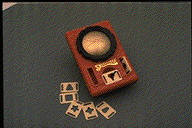
Figure 5: Skedoodle with Templates
Example 3: The Nulling Problem.
One of the most important characteristics of input devices is whether they
supply absolute or relative values. Other devices, such
as tablets, touch screens, and potentiometers return absolute values (determined
by their measured position). Earlier, I mentioned importance of the concept
of the "dimension of maximum importance." In this example, the
choice between absolute versus relative mode defines that dimension.
The example comes from process control. There are (at least) two philosophies
of design that can be followed in such applications. In the first, space
multiplexing, there is a dedicated physical transducer for every parameter
that is to be controlled. In the second, time multiplexing, there are fewer
transducers than parameters. Such systems are designed so that a single
device can be used to control different parameters at different stages of
an operation.
Let us assume that we are implementing a system based on time multiplexing.
There are two parameters, A and B, and a single sliding potentiometer to
control them, P. The potentiometer P outputs an absolute value proportional
to the position of the handle. To begin with, the control potentiometer
is set to control parameter A. The initial settings of A, B, and P are
all illustrated in Figure6A. First we want to raise the value of A to its
maximum. This we do simply by sliding up the controller, P. This leaves
us in the state illustrated in Figure 6B. We now want to raise parameter
B to its maximum value. But how can we raise the value of B if the controller
is already in its highest position? Before we can do anything we must adjust
the handle of the controller relative to the current value of B. This is
illustrated in Figure 6C. Once this is done, parameter B can be reset by
adjusting P. The job is done and we are in the state shown is Figure 6D
(fig 6 a,b,c,d - to be added)
FIGURE 6: The Nulling Problem.
Potentiometer P controls two parameters, A and B. The initial settings
are shown in Panel A. The position of P, after raising parameter A to its
maximum value, is shown in Panel B. In order for P to be used to adjust
parameter B, it must first be moved to match the value of B (i.e., "null"
their difference), as shown in Panels C and D.
.
From an operator's perspective, the most annoying part of the above transaction
is having to reset the controller before the second parameter can be adjusted.
This is called the nulling problem. It is common, takes time to
carry out, time to learn, and is a common source of error. Most importantly,
it can be totally eliminated if we simply choose a different transducer.
The problems in the last example resulted from the fact that we choose a
transducer that returned an absolute value based on a physical handle's
position. As an alternative, we could replace it with a touch-sensitive
strip of the same size. We will use this strip like a one-dimensional mouse.
Instead of moving a handle, this strip is "stroked" up or down
using a motion similar to that which adjusted the sliding potentiometer.
The output in this case, however, is a value whose magnitude is proportional
to the amount and direction of the stroke. In short, we get a relative
value which determines the amount of change in the parameter. We simply
push values up, or pull them down. The action is totally independent of
the current value of the parameter being controlled. There is no handle
to get stuck at the top or bottom. The device is like a treadmill, having
infinite travel in either direction. In this example, we could have "rolled"
the value up and down using one dimension of trackball and gotten much the
same benefit (since it too is a relative device).
An important point in this example is where the reduction in complexity
occurred: in the syntax of the control language. Here we have a compelling
and relevant example of where a simple change in input device has resulted
in a significant change in the syntactic complexity of a user interface.
The lesson to be learned is that in designing systems in a layered manner
- first the semantics, then the syntax, then the lexical component, and
the devices - we must take into account interaction among the various strata.
All components of the system interlink and have a potential effect
on the user interface. Systems must begin to be designed in an integrated
and holistic way.
PHRASING GESTURAL INPUT
Phrasing is a crucial component of speech and music. It determines the
ebb and flow of tension in a dialogue. It lets us know when a concept is
beginning, and when it ends. It tells us when to be attentive, and when
to relax. Why might this be of importance in our discussion of "body
language" in human-computer dialogue? Well, for all the same reasons
that it is important in all other forms of communication. Phrases "chunk"
related things together. They reinforce their connection. In this section
I attempt to demonstrate how we can exploit the benefits of phrasing by
building dialogues that enable connected concepts to be expressed by connected
physical gestures.
If you look at the literature, you will find that there has been a great
deal of study on how quickly humans can push buttons, point at text, and
type commands. What the bulk of these studies focus on is the smallest
grain of the human-computer dialogue, the atomic task. These are the "words"
of the dialogue. The problem is, we don't speak in words. We speak in
sentences. Much of the problem is applying the result s of such studies
is that they don't provide much help in understanding how to handle compound
tasks. My thesis is, if you can say it in words in a single phrase, you
should be able to express it to the computer in a single gesture. This
binding of concepts and gestures thereby becomes the means of articulating
the unit tasks of an application.
Most of the tasks which we freeform in interacting with computers
are compound. In indicating a point on the display with a mouse we think
of what we are doing as a single task: picking a point. But what would
you have to specify if you had to indicate the same point by typing? Your
single-pick operation actually consists of two sub-tasks: specifying an
X coordinate and specifying a Y coordinate. You were able to think of the
aggregate as a single task because of the appropriate match among transducer,
gesture, and context. The desired one-to-one mapping between concept and
action has been maintained. My claim is that what we have seen in this
simple example can be applied to even higher-level transactions.
Two useful concepts from music that aid in thinking about phrasing are tension
and closure. During a phrase there is a state of tension associated
with heightened attention. This is delimited by periods of relaxation that
close the thought and state implicitly that another phrase can be introduced
by either party in the dialogue. It is my belief that we can reap significant
benefits when we carefully design our computer dialogues around such sequences
of tension and closure. In manual input, I will want tension in imply muscular
tension.
Think about how you interact with pop-up menus with a mouse.
Normally you push down the select button, indicate your choice by moving
the mouse, and then release the select button to confirm the choice. Your
are in a state of muscular tension throughout the dialogue: a state that
corresponds exactly with the temporary state of the system. Because of
the gesture used, it is impossible to make an error in syntax, and you have
a continual active reminder that you are in an uninterruptable temporary
state. Because of the gesture used, there is none of the trauma normally
associated with being in a mode. That you are in a mode is ironic, since
it is precisely the designers of "modeless" systems that make
the heaviest use of this technique. The lesson here is that it is not modes
per se that cause problems.
In well-structured manual input there is a kinesthetic connectivity
to reinforce the conceptual connectivity of the task. We
can start to use such gestures to help develop the role of muscle memory
as a means through which to provide mnemonic aids for performing different
tasks. And we can start to develop the notion of gestural self-consistency
across an interface.
What do graphical potentiometer, pop-up menus, scroll-bars,
rubber-band lines, and dragging all have in common? Answer: the potential
to be implemented with a uniform form of interaction. Work it out using
the pop-up menu protocol given above.
WE HAVE TWO HANDS
It is interesting that the manufacturers of arcade video games seem to recognize
something that the majority of mains-stream computer systems ignore: that
users are capable of manipulating more than one device at a time in the
course of achieving a particular goal. Now this should come as no surprise
to anyone who is familiar with driving an automobile. But it would be news
to the hypothetical anthropologist that we introduced at the start of the
chapter. There are two questions that we introduced at the start of the
chapter. There are two questions here: "Is anything gained by using
two hands?" and "If there is, why aren't we doing it?"
The second question is the easier of the two. With a few exceptions, (the
Xerox Star, for example), most systems don't encourage two-handed multiple-device
input. First, most of our theories about parsing languages (such as the
language of our human-computer dialogue) are only capable of dealing with
single-threaded dialogues. Second, there are hardware problems due partially
to wanting to do parallel things on a serial machine. Neither of these
is unsolvable. But we do need some convincing examples that demonstrate
that the time, effort, and expense is worthwhile. So that is what I will
attempt to do in the rest of this section.
Example 4: Graphics Design Layout
I am designing a screen to be used in a graphics menu-based system. To
be effective, care must be taken in the screen layout. I have to determine
the size and placement of a figure and its caption among some other graphical
items. I want to use the tablet to preview the figure in different locations
and at different sizes in order to determine where it should finally appear.
The way that this would be accomplished with most current systems is to
go through a cycle of position-scale-position-... actions. That is, in
order to scale, I have to stop positioning, and vice versa.
This is akin to having to turn off your shower in order to
adjust the water temperature.
An alternative design offering more fluid interaction is to position it
with one hand and scale it with the other. By using two separate devices
I am able to perform both tasks simultaneously and thereby achieve a far
more fluid dialogue.
Example 5: Scrolling
A common activity in working with many classes of program is scrolling through
data, looking for specific items. Consider scrolling through the text of
a document that is being edited. I want to scroll till I find what I'm
looking for, then mark it up in some way. With most window systems, this
is accomplished by using a mouse to interact with some (usually arcane)
scroll bar tool. Scrolling speed is often difficult to control and the
mouse spends a large proportion of its time moving between the scroll bar
and the text. Furthermore, since the mouse is involved in the scrolling
task, any ability to mouse ahead (i.e. start moving the mouse towards
something before it appears on the display) is eliminated. If a mechanism
were provided to enable us to control scrolling with the nonmouse hand,
the whole transaction would be simplified.
There is some symmetry here. It is obvious that the same
device used to scale the figure in the previous example could be used to
scroll the window in this one. Thus, we ourselves would be time-multiplexing
the device between the scaling of examples. An example of space-multiplexing
would be the simultaneous use of the scrolling device and the mouse. Thus,
we actually have a hybrid type of interface.
Example 6: Financial Modeling
I am using a spread-sheet for financial planning. The method used to change
the value in a cell is to point at it with a mouse and type the new entry.
For numeric values, this can be done using the numeric keypad or the typewriter
keyboard. In most such systems, doing so requires that the hand originally
on the mouse moves to the keyboard for typing. Generally, this requires
that the eyes be diverted from the screen to the keyboard. Thus, in order
the check the result, the user must then visually relocate the cell on a
potentially complicated display.
An alternative approach is to use the pointing device in one hand and the
numeric keyboard in the other. The keypad hand can then remain in the home
position, and if the user can touch-type on the keypad, the eyes need never
leave the screen during the transaction.
Note that in this example the tasks assigned to the two hands
are not even being done in parallel. Furthermore, a large population of
users - those who have to take notes while making calculations - have developed
keypad touch-typing facility in their nonmouse hand (assuming that the same
hand is used for writing as for the mouse). So if this technique is viable
and presents no serious technical problems, then why is it not in common
use? One arguable explanation is that on most systems the numeric keypad
is mounted on the same side as the mouse. Thus, physical ergonomics prejudice
against the approach.
WHAT ABOUT TRAINING?
Some things are hard to do; they take time and effort before they can be
performed at a skilled level. Whenever the issue of two-handed input comes
up, so does some facsimile of the challenge, "But two-handed actions
are hard to coordinate." Well, the point is true. But is also false!
Learning to change gears is hard. So is playing the piano. But on the
other hand, we have no trouble turning pages with one hand while writing
with the other.
Just because two-handed input is not always suitable is no reason to reject
it. The scrolling example described above requires trivial skills, and
it can actually reduce errors and learning time. Multiple-handed input
should be one of the techniques considered in design. Only its appropriateness
for a given situation can determine if it should be used. In that, it is
no different than any other technique in our repertoire.
Example 7: Financial Modeling Revisited
Assume that we have implemented the two-handed version of the spreadsheet
program described in Example 6. In order to get the benefits that I suggested,
the user would have to be a touch-typist on the numeric keypad. This is
a skilled task that is difficult to develop. There is a temptation, then,
to say "don't use it." If the program was for school children,
then perhaps that would be right. But consider who uses such programs:
accountants, for example. Thus, it is reasonable to assume that a significant
proportion of the user population comes to the system with the skill
already developed. By our implementation, we have provided a convenience
for those with the skill, without imposing any penalty on those without
it - they are no worse off than they would be in the one-handed implementation.
Know your user is just another (and important) consideration that
can be exploited in order to tailor a better user interface.
CONCLUSIONS
I began this chapter by pointing out that there are major shortcomings in
our ability to manually enter information into a computer. To this point,
input has lagged far behind graphical output. As yet, as some of our examples
illustrate, input is of critical importance. If we are to improve the quality
of human-computer interfaces we must begin to approach input from two different
views. First, we must look inward to the devices and technologies at the
finest grain of their detail. One of the main points that I have made is
that some of the most potent and useful characteristics on input devices
only surface when they are analyzed at a far lower level of detail than
has commonly been the case.
Second, we must look outward from the devices themselves to how they fit
into a more global, or holistic, view of the user interface. All aspects
of the system affect the user interface. Often problems at one level of
the system can be easily solved by making a change at some other level.
This was shown for example, in the discussion of the nulling problem.
That the work needs to be done is clear. Now that we've made up our minds
about that, all that we have to do is assemble good tools and get down to
it. What could be simpler?
SUGGESTED READINGS
The literature on most of the issues that are dealt with in this chapter
is pretty sparse. One good source that complements many of the ideas discussed
is Foley, Wallace, and Chan (1984). A presentation on the notion of virtual
devices can be found in Foley and Wallace (1974). A critique of their use
can be found in Baecker (1980). This paper by Baecker is actually part
of an important and informative collection of papers on interaction (Guedj,
ten Hagen, Hopgood, Tucker, & Duce, 1980).
Some of the notions of "chunking" and phrasing discussed are expanded
upon in Buxton (1982) and Buxton, Fiume, Hill, Lee and Woo (1983). The
chapter by Miyata and Norman in this book gives a lot of background on performing
multiple tasks, such as in two-handed input. Buxton (1983) presents an
attempt to begin to formulate a taxonomy of input devices. This is done
with respect to the properties of devices that are relevant to the styles
of interaction that they will support. Evans, Tanner, and Wein (1981) do
a good job of demonstrating the extent to which one device can emulate properties
of another. Their study uses the tablet to emulate a large number of other
devices.
A classic study that can be used as a model for experiments to compare input
devices can be found in Card, English, and, Burr (1978). Another classic
study which can serve as the basis for modeling some aspects of performance
of a given user performing a given task using given transducers is Card,
Moran, and Newell (1980). My discussion in this chapter illustrates how,
in some cases, the only way that we can determine answers is by testing.
This means prototyping that is often expensive. Buxton, Lamb, Sherman
and Smith (1983) present one example of a tool that can help this process.
Olsen, Buxton, Ehrich, Kasik, Rhyne, and Sibert (1984) discusses the environment
in which such tools are used. Tanner and Buxton (1985) present a general
model of User Interface Management Systems. Finally, Thomas and Hamlin
(1983) present an overview of "User Interface Management Tools".
Theirs is a good summary of many user interface issues, and has a fairly
comprehensive bibliography.
ACKNOWLEDGMENTS
This chapter was written during a work period at Xerox Palo Alto Research
Center. During its preparation I had some very helpful input from a number
of people, especially Stu Card, Jerry Farrell, Lissa Monty, and Peter Tanner.
The other authors of this book also made some insightful and useful comments.
To them all, I offer my thanks.
REFERENCES
Baecker, R.M. (1980a). Towards an Effective Characterization of graphical
Interaction, in Guedj, R.A., ten Hagen, P., Hopgood, F.R., Tucker, H. and
Duce, D.A. (Eds.), Methodology of Interaction, Amsterdam: North
Holland Publishing, 127-148.
Buxton, W. (1986). Chunking and phrasing and the design of human-computer
dialogues, Proceedings of the IFIP World Computer Congress, Dublin,
Ireland, 475-480.
Buxton, W. (1983). Lexical and Pragmatic Considerations of Input Structures.
Computer Graphics 17 (1), 31-37.
Buxton, W., Fiume, E., Hill, R., Lee, A. & Woo, C. (1983). Continuous
Hand-Gesture Driven Input. Proceedings of Graphics Interface '83, 9th
Conference of the Canadian Man-Computer Communications Society, Edmonton,
May 1983, 191-195.
Buxton, W., Lamb, M. R., Sherman, D. & Smith, K. C. (1983). Towards
a Comprehensive User Interface Management System. Computer Graphics
17(3). 31-38.
Card, S., English & Burr. (1978), Evaluation of Mouse, Rate-Controlled
Isometric Joystick, Step Keys and Text Keys for Text Selection on a CRT,
Ergonomics, 21(8), 601-613.
Card, S., Moran, T. & Newell, A. (1980). The Keystroke Level Model
for User Performance Time with Interactive Systems, Communications of
the ACM, 23(7), 396-410.
Card, S., Moran, T. & Newell, A. (1983). The Psychology of Human-Computer
Interaction, Hillsdale, N.J.: Lawrence Erlbaum Associates.
Evans, K., Tanner, P. & Wein, M. (1981). Tablet-Based Valuators That
Provide One, Two, or Three Degrees of Freedom. Computer Graphics,
15 (3), 91-97.
Foley, J.D. & Wallace, V.L. (1974). The Art of Graphic Man-Machine
Conversation, Proceedings of IEEE, 62 (4), 462-4 7 0.
Foley, J.D., Wallace, V.L. & Chan, P. (1984). The Human Factors of
Computer Graphics Interaction Techniques. IEEE Computer Graphics and
Applications, 4 (11), 13-48.
Guedj, R.A., ten Hagen, P., Hopgood, F.R., Tucker, H. and Duce, D.A. (Eds.),
Methodology of Interaction, Amsterdam: North Holland Publishing,
127-148.
Olsen, D. R., Buxton, W., Ehrich, R., Kasik, D., Rhyne, J. & Sibert,
J. (1984). A Context for User Interface Management. IEEE Computer Graphics
and Applications 4(12), 33-42.
Tanner, P.P. & Buxton, W. (1985). Some Issues in Future User Interface
Management System (UIMS) Development. In Pfaff, G. (Ed.), User Interface
Management Systems, Berlin: Springer Verlag, 67- 79.
Thomas and Hamlin (1983)









